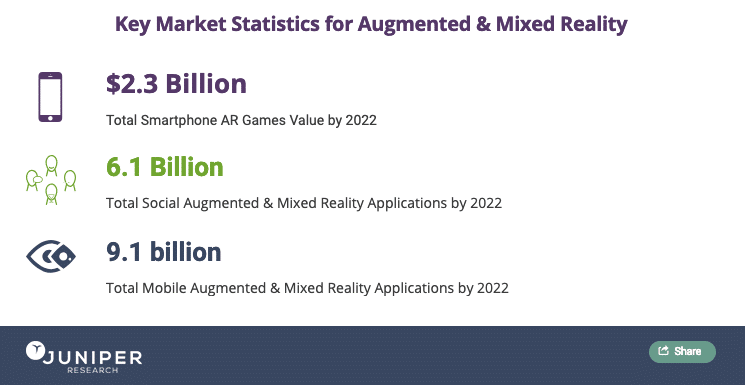
Data Point of the Week is AR Insider’s weekly dive into data from around the XR universe. Spanning usage and market-sizing data, it’s meant to draw insights for XR players or would-be entrants. To see an indexed archive of data and narrative reports, subscribe to ARtillery PRO.
How many licks does it take to get to the center of a Tootsie Pop? Wait, that’s a different article. How many mobile AR apps are in the wild? The latest comes from Superdata, which reported 3,070 apps at the recent ARiA show. That’s 85 percent ARkit and 15 percent ARCore.
We’ve seen intermittent data from app analytics firms like Sensor Tower, indicating 2000 total ARkit apps earlier this year. Though the firms have different methodologies, directionally it implies about 50 percent growth over six months, which annualizes to about 100 percent (or 2x) growth.

That percentage growth will decelerate, as happens when the base figure grows. But it still indicates strong developer activity. There’s greater growth in AR users, so demand outpaces supply (more on that in a bit), but it could also just mean consolidated use in a few top AR apps.
Bringing in a third data set, Juniper projects 9.1 million mobile AR apps by 2022. It also projects 6.1 million social AR apps — a key area of growth. The 6.1 million figure goes beyond mobile and includes AR glasses. As always, check methodologies before taking action with forecast data.*
It’s also important to consider what’s included in these disparate studies. Some of the above figures like Sensor Tower measure AR-only apps. It doesn’t count “AR as a feature” within non-AR apps, which happen to be the most popular AR today (Amazon AR View, Snapchat Lenses).
Those caveats aside, why is all this important? App volume represents the supply side of the supply/demand equation. It can inform AR platform decisions. For example, web AR can sidestep crowded app stores, and reduce users’ download friction — critical in demand-sparse early days.

Speaking of which, what does mobile AR demand look like? According to data from our sister-research firm ARtillery Intelligence, there are 139 million active AR users globally, growing to just over a billion by 2022. That includes AR as a feature (non-AR primary apps) and web AR.
In terms of growth, that’s roughly 170 percent growth in AR active users in 2018 (not speaking to usage volume or frequency). That rate will slow over time — again, as often happens with a larger base. But we’re on pace for the projected 1 billion AR active users in 2022.
Of course, that could, and likely will, shift with market events over the coming months and years. We’ll be watching closely and course-correcting figures and projections as those dynamic market shifts and inflections points happen. Stay tuned for more data tidbits and takeaways here.

* Any market-sizing figures (including that of our research arm ARtillery Intelligence) should be taken with a grain of salt. Methodologies for data collection should always be examined. The same goes for the above thought exercise in extrapolating figures for directional market estimates.
For deeper XR data and intelligence, join ARtillery PRO and subscribe to the free AR Insider Weekly newsletter.
Disclosure: AR Insider has no financial stake in the companies mentioned in this post, nor received payment for its production. Disclosure and ethics policy can be seen here.
